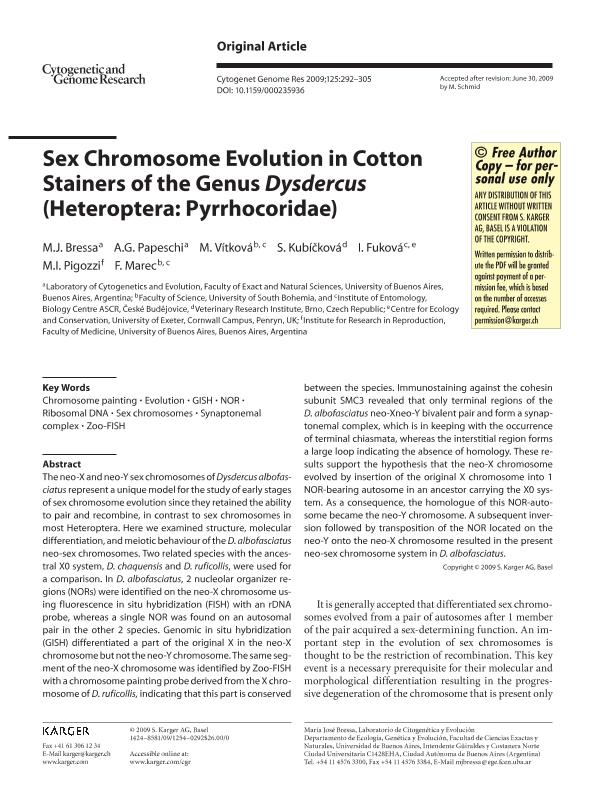Mostrar el registro sencillo del ítem
dc.contributor.author
Bressa, Maria Jose

dc.contributor.author
Papeschi, Alba Graciela

dc.contributor.author
Vítková, M.
dc.contributor.author
Kubícková, S.
dc.contributor.author
Fuková, I.
dc.contributor.author
Pigozzi, Maria Ines

dc.contributor.author
Marec, F.
dc.date.available
2022-08-01T10:46:39Z
dc.date.issued
2009-12
dc.identifier.citation
Bressa, Maria Jose; Papeschi, Alba Graciela; Vítková, M.; Kubícková, S.; Fuková, I.; et al.; Sex chromosome evolution in cotton stainers of the genus dysdercus (Heteroptera: Pyrrhocoridae); Karger; Cytogenetic And Genome Research; 125; 4; 12-2009; 292-305
dc.identifier.issn
1424-8581
dc.identifier.uri
http://hdl.handle.net/11336/163605
dc.description.abstract
The neo-X and neo-Y sex chromosomes of Dysdercus albofasciatus represent a unique model for the study of early stages of sex chromosome evolution since they retained the ability to pair and recombine, in contrast to sex chromosomes in most Heteroptera. Here we examined structure, molecular differentiation, and meiotic behaviour of the D. albofasciatus neo-sex chromosomes. Two related species with the ancestral X0 system, D. chaquensis and D. ruficollis, were used for a comparison. In D. albofasciatus, 2 nucleolar organizer regions (NORs) were identified on the neo-X chromosome using fluorescence in situ hybridization (FISH) with an rDNA probe, whereas a single NOR was found on an autosomal pair in the other 2 species. Genomic in situ hybridization (GISH) differentiated a part of the original X in the neo-X chromosome but not the neo-Y chromosome. The same segment of the neo-X chromosome was identified by Zoo-FISH with a chromosome painting probe derived from the X chromosome of D. ruficollis, indicating that this part is conserved between the species. Immunostaining against the cohesin subunit SMC3 revealed that only terminal regions of the D. albofasciatus neo-Xneo-Y bivalent pair and form a synaptonemal complex, which is in keeping with the occurrence of terminal chiasmata, whereas the interstitial region forms a large loop indicating the absence of homology. These results support the hypothesis that the neo-X chromosome evolved by insertion of the original X chromosome into 1 NOR-bearing autosome in an ancestor carrying the X0 system. As a consequence, the homologue of this NOR-autosome became the neo-Y chromosome. A subsequent inversion followed by transposition of the NOR located on the neo-Y onto the neo-X chromosome resulted in the present neo-sex chromosome system in D. albofasciatus.
dc.format
application/pdf
dc.language.iso
eng
dc.publisher
Karger

dc.rights
info:eu-repo/semantics/openAccess
dc.rights.uri
https://creativecommons.org/licenses/by-nc-sa/2.5/ar/
dc.subject
CHROMOSOME PAINTING
dc.subject
EVOLUTION
dc.subject
GISH
dc.subject
NOR
dc.subject
RIBOSOMAL DNA
dc.subject
SEX CHROMOSOMES
dc.subject
SYNAPTONEMAL COMPLEX
dc.subject
ZOO-FISH
dc.subject.classification
Otras Ciencias Biológicas

dc.subject.classification
Ciencias Biológicas

dc.subject.classification
CIENCIAS NATURALES Y EXACTAS

dc.title
Sex chromosome evolution in cotton stainers of the genus dysdercus (Heteroptera: Pyrrhocoridae)
dc.type
info:eu-repo/semantics/article
dc.type
info:ar-repo/semantics/artículo
dc.type
info:eu-repo/semantics/publishedVersion
dc.date.updated
2020-05-11T15:48:26Z
dc.journal.volume
125
dc.journal.number
4
dc.journal.pagination
292-305
dc.journal.pais
Suiza

dc.journal.ciudad
Basel
dc.description.fil
Fil: Bressa, Maria Jose. Universidad de Buenos Aires. Facultad de Ciencias Exactas y Naturales. Departamento de Ecología, Genética y Evolución; Argentina. Consejo Nacional de Investigaciones Científicas y Técnicas. Oficina de Coordinación Administrativa Ciudad Universitaria. Instituto de Ecología, Genética y Evolución de Buenos Aires. Universidad de Buenos Aires. Facultad de Ciencias Exactas y Naturales. Instituto de Ecología, Genética y Evolución de Buenos Aires; Argentina
dc.description.fil
Fil: Papeschi, Alba Graciela. Consejo Nacional de Investigaciones Científicas y Técnicas; Argentina. Universidad de Buenos Aires. Facultad de Ciencias Exactas y Naturales. Departamento de Ecología, Genética y Evolución; Argentina
dc.description.fil
Fil: Vítková, M.. Institute Of Entomology. Department Of Genetics; Republica Checa
dc.description.fil
Fil: Kubícková, S.. Veterinary Research Institute; República Checa
dc.description.fil
Fil: Fuková, I.. Institute Of Entomology. Department Of Genetics; Republica Checa
dc.description.fil
Fil: Pigozzi, Maria Ines. Universidad de Buenos Aires. Facultad de Medicina; Argentina. Consejo Nacional de Investigaciones Científicas y Técnicas; Argentina
dc.description.fil
Fil: Marec, F.. Institute Of Entomology. Department Of Genetics; Republica Checa
dc.journal.title
Cytogenetic And Genome Research

dc.relation.alternativeid
info:eu-repo/semantics/altIdentifier/url/https://www.karger.com/Article/Abstract/235936
dc.relation.alternativeid
info:eu-repo/semantics/altIdentifier/doi/http://dx.doi.org/10.1159/000235936
Archivos asociados
